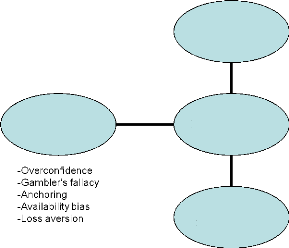4.4 Conclusion
This study to a large extent, succeeded in establishing a
relationship between financial regulations, risk management and value creation
bearing in mind that these are not the only factors influencing the investment
decision-making process. It was revealed in this study that financial
regulations, risks management and value creation are the most influential
factors influencing investors in the investment decision-making process
although there are some other socio-psychological factors alongside. This study
also revealed that the behavioural school of finance is in support of the
observation that if the `music is playing you have to get up and dance'. Note
that the risks involved and the expected return need to be clearly established
first before any investment decision can be made. Therefore, it is the starting
point in the investment decision making process.
CHAPTER FIVE
CONCLUSIONS AND RECOMMENDATIONS
5.1 Introduction
In this chapter, the findings and analysis in the other
chapters together with the review of the existing literature brought out in
chapter two will be use for conclusions and in establishing whether or not
there exist a relationship between financial regulations, risk management and
value creation within financial institutions. This chapter should also be able
to tell whether the research questions were answered as well as confirming
whether the objectives of this study were achieved. In this section of the
study, some recommendations will also be made which can be helpful for future
research.
5.2 Overall Assessment of the Aims and Objectives
Attainment.
This study was aimed at understanding how financial
regulations, risk management and value creation together with other factors
influence the investment decision-making process of financial institutions.
This section of the study will examine the aims and objectives of the study as
well as proving whether or not these aims and objectives were attained. This
goes alongside making sure that the research questions asked at the beginning
of this study have been answered. If these questions have been answered, then
it justifies that the aims and objectives of this study have been attained.
In chapter two of this study, the meanings of financial
regulations, risk management and value creation were explained. Also the
reasons for financial regulations, risk management and value creation were
brought out. In addition to that, the methods of financial regulations, risk
management and value creation were brought to light. Still within the contents
of chapter two, the different types of risks affecting the performance of
financial institutions and how these
institutions manage these risks were explained. By
implication, it is obvious that the finding was able to provide answers to all
the research questions raised at the beginning of this study as well as meeting
the aims and objectives of this study.
5.3 Conclusion
The global crisis has proven that systemic threats posed by
irresponsible practices within the financial services industry can cause the
collapse of the international financial system. Owing to the behavioural
factors discussed above, any proposed reforms may prove insufficient to prevent
excess risk-taking. Owing to the above, this study suggests the creation of a
new global regulatory consensus with respect to redrawing the current model of
the national as well as international financial regulations. Under the
suggested model, the high risk/ high return activities will be monitored and
banking institutions involved in higher risks activities would be obliged to
buy excessive liquidity insurance as well as having limited access to cheap
funding basis. Arguably, the combined outcome of any suggested measures would
result to a safer banking industry and better customer services.
The consequences of the financial crisis on the global economy
and the fragility of the global financial system have proved beyond doubts that
doing much of the same is a gamble which western governments will not
like to participate. Therefore this is the right time to advance regulatory
reforms seeking to replace the `failed' model of the financial regulations with
a new one that will be able to liberate the creative forces of the market as
well as containing the social costs. The following diagram provides a summary
of this study.
Figure 10: Summary

Other Factors:
Financial Regulations
Investment
Decision-Making
Risk Management

Value Creation
All in all, financial regulations are cushions struggling to
limit investment decisions which do not comply with the law. Value creation is
the primary objective of any business entity and is geared towards adding an
additional value to the already existing bottom line. With all these in place,
the risk management team trying to comply with the government and its financial
regulations as well as creating value within its institution implies that there
exist a relationship between financial regulations, risk management and value
creation. The question being asked by this risk management team is whether it
is actually worth taking such risks.
The diagram above tells us that the investment decision-making
process within financial institutions is made possible with the combination of
financial regulations, risk management, value creation and other factors
(behavioural factors). Note that, any thing done within any business be it in a
financial sector or elsewhere is directed towards investment decision-making as
shown in the diagram above.
| 

